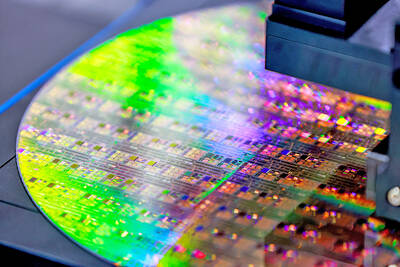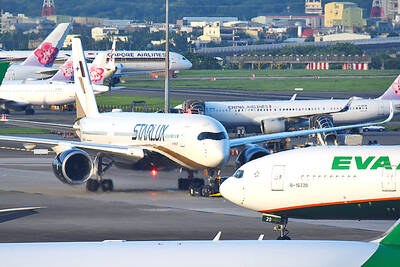The share performance of Hon Hai Precision Industry Co (鴻海精密) has been eye-catching this year, rising 23.1 percent, which nearly triples the increase in the benchmark TAIEX over the same period.
Hon Hai shares closed at NT$98.6 on Friday in Taipei trading.
While share price generally reflects investor expectations for future earnings growth and consequently for future investment returns, the sustainability of Hon Hai upward trend remains a question.
Barclays Capital Securities Ltd, Macquarie Capital Securities Ltd and JPMorgan Securities Ltd remain positive on the company’s business outlook, saying Hon Hai will benefit from its role as a key assembler for Apple Inc’s iPhone 6.
Last week, Barclays raised its target price on Hon Hai shares to NT$120 from NT$105 and Macquarie lifted its target price to NT$108 from NT$100, while JPMorgan retained its “overweight” rating on the stock with a price target of NT$100.
At least one analyst has expressed caution about Hon Hai’s room for future growth.
“We think 2014 could be the best year for Hon Hai,” Arthur Hsieh (謝宗文), chief electronics hardware analyst at UBS Securities Pte Ltd Taipei branch, said last week.
The firm maintained its “sell” recommendation on the stock, with a target price of NT$75.
In a research report issued on Thursday — one day after Hon Hai chairman Terry Gou (郭台銘) presented the company’s business strategy and possible long term growth opportunities at the annual general meeting — UBS said it is not as optimistic as Gou is about the company’s business this year.
For instance, UBS forecast the company’s revenue would grow 4.4 percent to NT$4.12 trillion (US$588 billion) this year from NT$3.95 billion last year, lower than Gou’s revenue growth target of over 10 percent.
The brokerage also predicted Hon Hai’s net income would increase by merely 0.6 percent to NT$107.32 billion this year from NT$106.7 billion last year, much weaker than Gou’s predictions of more than 10 percent growth.
What worries UBS most however, is Gou’s multi-year corporate restructuring plan as he aims to develop the world’s largest contract electronics maker into a technology-service provider rather than a hardware manufacturer.
The transition plan refers to Gou’s intention to engage in more value-added services such as innovative integrated design manufacturing plus sales and marketing, a diversification from the company’s conventional contract manufacturing business.
At the meeting on Wednesday, Gou also highlighted several new investment projects the company plans to launch in the second half of this year to the first half of next year, including broadband connectivity, cloud technology services, automation, robotics and products related to electric vehicles.
He told shareholders that the company’s earnings would keep growing in the next three years, driven by product and customer diversification.
However, Hsieh warned that this transition could increase the risk of a potential conflict of interest with some clients in the same market segment in terms of the sales and marketing of end-products, while new investments would take time to complete with meaningless revenue contribution initially, he said.
“We are concerned about the outlook for 2015-2017 given the coming big transition in the business model,” Hsieh said. “Our analysis suggests even if Hon Hai gains a meaningful share in the Japanese robot market or in Tesla’s potential outsourcing business, the contribution could be very limited.”
Gou told shareholders that Hon Hai has teamed up with Japan’s Softbank Corp to manufacture the world’s first personal robot, Pepper, and is collaborating with the US-based Tesla Motors Inc to manufacture touch screen for them.
UBS said its research showed that Pepper would contribute only 0.5 percent to 0.9 percent of Hon Hai’s total sales for next year and the Tesla partnership would just add between 0.2 percent and 0.3 percent.
Additional reporting by Lisa Wang

Taiwan’s rapidly aging population is fueling a sharp increase in homes occupied solely by elderly people, a trend that is reshaping the nation’s housing market and social fabric, real-estate brokers said yesterday. About 850,000 residences were occupied by elderly people in the first quarter, including 655,000 that housed only one resident, the Ministry of the Interior said. The figures have nearly doubled from a decade earlier, Great Home Realty Co (大家房屋) said, as people aged 65 and older now make up 20.8 percent of the population. “The so-called silver tsunami represents more than just a demographic shift — it could fundamentally redefine the

The US government on Wednesday sanctioned more than two dozen companies in China, Turkey and the United Arab Emirates, including offshoots of a US chip firm, accusing the businesses of providing illicit support to Iran’s military or proxies. The US Department of Commerce included two subsidiaries of US-based chip distributor Arrow Electronics Inc (艾睿電子) on its so-called entity list published on the federal register for facilitating purchases by Iran’s proxies of US tech. Arrow spokesman John Hourigan said that the subsidiaries have been operating in full compliance with US export control regulations and his company is discussing with the US Bureau of

Businesses across the global semiconductor supply chain are bracing themselves for disruptions from an escalating trade war, after China imposed curbs on rare earth mineral exports and the US responded with additional tariffs and restrictions on software sales to the Asian nation. China’s restrictions, the most targeted move yet to limit supplies of rare earth materials, represent the first major attempt by Beijing to exercise long-arm jurisdiction over foreign companies to target the semiconductor industry, threatening to stall the chips powering the artificial intelligence (AI) boom. They prompted US President Donald Trump on Friday to announce that he would impose an additional

China Airlines Ltd (CAL, 中華航空) said it expects peak season effects in the fourth quarter to continue to boost demand for passenger flights and cargo services, after reporting its second-highest-ever September sales on Monday. The carrier said it posted NT$15.88 billion (US$517 million) in consolidated sales last month, trailing only September last year’s NT$16.01 billion. Last month, CAL generated NT$8.77 billion from its passenger flights and NT$5.37 billion from cargo services, it said. In the first nine months of this year, the carrier posted NT$154.93 billion in cumulative sales, up 2.62 percent from a year earlier, marking the second-highest level for the January-September